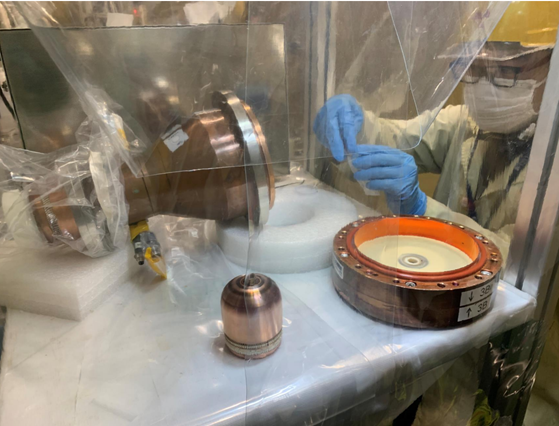Injector operation
The measurements with the new EMU (Emittance Meter Unit) were interrupted at the end of April because of an HV standoff issue due to a broken ceramic insulator placed at the repeller electrode. As the replacement of the ceramic insulator implies to open the injector chamber and break the vacuum, it was pointless to resume EMU qualitative characterization. It was then decided to change the PE (plasma electrode) to the 12mm size (as already planned).
During the inspection the BN (Boron Nitride) disks were also found strongly damaged and therefore replaced, it was to be expected considering the number of beam extraction and operational hours since their last replacement. We have currently a major intervention on going on the RFQ couplers. The vault is then open in the day time and injector operation can resume at around 17h30, for a shift until 21h30. While during the night and over weekends, plasma conditioning is performed. Until now efforts have been made to increase the extracted beam current remaining at 5 or 10%DC (duty cycle); current was progressively increased from 130 to 150 mA before some arcs appeared. From this week, beam characterization with the 12mm PE will start.
RFQ couplers
The RFQ cavity is currently vented with N2 at atmospheric pressure. The intervention on the couplers was slowed down mainly due to the technical difficulties (including long and delicate preparation work) and necessity to train adequately the staff by the experts. INFN supported remote training sessions on a spare coupler before the intervention was authorized. After the previous leak tests, the RFQ coupler#3b was suspected to leak and thus it has been the first disassembled and inspected. The window was found with sign of Cu deposition and with partly melted o-ring. The RF window parameters have been measured with network analyzer and the data are analyzed. Considering the time needed to inspect each coupler and replace the o-rings, we will not be able to have few weeks of beam operation in July. Accelerating the activity on the couplers implies unacceptable and not justified technical risks, additionally contractual maintenance onsite starts on August 1st.
We have also started to prepare a high power test bench (using a bridge cavity that was available onsite) to be able to tests at high power the new RF windows before their installation on the RFQ itself. This will eliminate the risk that a window with imperceptible impurities could break when used at full RF power. The bridge cavity is currently being characterized that is the measurement of RF parameters and tuning, while mechanical interfaces, possible location, cooling options are studied.
RF system
After receiving the spares onsite, the circulator of the RF-RFQ chain#1b was repaired following the instructions provided by the supplier. We are ready to perform some quick functional tests in these days. As the possibility to have beam operation is summer has been discarded, the circulator will be finally shipped back to the supplier for a repair at their premises. Even though it wastechnically the best option since the beginning, but it was not adopted for the long time needed (4 months), non-compatibility with operation in summer and the non-null chances of success of the repair onsite. As the conditioning will resume now in October, it becomes the appropriate option.
We target to have the #1b chain operational by end of October along with the RFQ. Depending on the outcome of inspections and analyses of the RF windows, the best option for the experimental campaign after the summer break will be considered: resume RFQ conditioning aiming at CW or resume beam operation at low power, low DC.
Since beginning of May, after more than 2 years of entry ban in Japan, we could welcome 5 new colleagues from Spain. 2 senior experts from CIEMAT (and old acquaintance of the project) and 3 new engineers for Granada University. We could immediately feel the positive energy and the increase of our working force in the commissioning of the HEBT and BD and in the maintenance activities. Among whom, 4 of them will stay in Rokkasho for at least 1 year.

Disclaimer: the information reported is not meant to be technically complete and doesn’t cover all the activities currently carried out on LIPAc.


